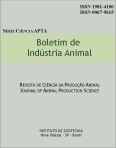Corn in consortium with forages
Keywords:
Panicum spp., Urochloa spp, Zea maysAbstract
The basic premises for sustainable agricultural development with focus on rural producers are reducing the costs of production and aggregation of values through the use crop-livestock system (CLS) throughout the year. The CLS is based on the consortium of grain crops, especially corn with tropical forages, mainly of the genus Panicum and Urochloa. The study aimed to evaluate the grain yield of irrigated corn crop intercropped with forage of the genus Panicum and Urochloa. The experiment was conducted at the Fazenda de Ensino, Pesquisa e Extensão €“ FEPE of the Faculdade de Engenharia - UNESP, Ilha Solteira in an Oxisol in savannah conditions and in the autumn winter of 2009. The experimental area was irrigated by a center pivot and had a history of no-tillage system for 8 years. The corn hybrid used was simple DKB 390 YG at distances of 0.90 m. The seeds of grasses were sown in 0.34 m spacing in the amount of 5 kg ha-1, they were mixed with fertilizer minutes before sowing and placed in a compartment fertilizer seeder and fertilizers were mechanically deposited in the soil at a depth of 0.03 m. The experimental design used was a randomized block with four replications and five treatments: Panicum maximum cv. Tanzania sown during the nitrogen fertilization (CTD) of the corn; Panicum maximum cv. Mombaça sown during the nitrogen fertilization (CMD) of the corn; Urochloa brizantha cv. Xaraés sown during the occasion of nitrogen fertilization (CBD) of the corn; Urochloa ruziziensis cv. Comumsown during the nitrogen fertilization (CRD) of the corn and single corn (control). The production components of corn: plant population per hectare (PlPo), number of ears per hectare (NE ha-1), number of rows per ear (NRE), number of kernels per row on the cob (NKR), number of grain in the ear (NGE) and mass of 100 grains (M100G) were not influenced by consortium with forage. Comparing grain yield (GY) single corn and maize intercropped with forage of the genus Panicum and Urochloa, there were no differences between treatments, even with higher averages in the consortium when compared with single corn. Regarding the dry mass production (DMP) of forages, the consortium CMD had the highest average yield; however, it did not differ significantly of consortiums CBD and CRD. Already the consortium CTD submitted the lowest DMP, but also did not differ significantly from consortia CBD and CRD. The corn intercropped with forages of the genus Panicum and Urochloa did not influence growth and grain yield of irrigated corn no-tillage system in the savannah.Downloads
Downloads
Published
Issue
Section
License
Os autores não serão remunerados pela publicação de trabalhos, pois devem abrir mão de seus direitos autorais em favor deste periódico. Por outro lado, os autores ficam autorizados a publicar seus artigos, simultaneamente, em repositórios da instituição de sua origem, desde que citada a fonte da publicação original seja Boletim de Indústria Animal. A revista se reserva o direito de efetuar, nos originais, alterações de ordem normativa, ortográfica e gramatical, com vistas a manter o padrão culto da língua e a credibilidade do veículo. Respeitará, no entanto, o estilo de escrever dos autores. Alterações, correções ou sugestões de ordem conceitual serão encaminhadas aos autores, quando necessário. Nesses casos, os artigos, depois de adequados, deverão ser submetidos a nova apreciação. As opiniões emitidas pelos autores dos artigos são de sua exclusiva responsabilidade. Todo o conteúdo deste periódico, exceto onde está identificado, está licenciado sob a Licença Creative Commons Attribution (CC-BY-NC). A condição BY implica que os licenciados podem copiar, distribuir, exibir e executar a obra e fazer trabalhos derivados com base em que só se dão o autor ou licenciante os créditos na forma especificada por estes. A cláusula NC significa que os licenciados podem copiar, distribuir, exibir e executar a obra e fazer trabalhos derivados com base apenas para fins não comerciais.













